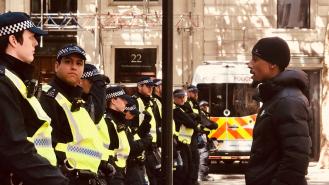
The murder of Sarah Everard: How the Met Police failed women
It was around 9pm in South London on 3rd March 2021, and 33-year-old Sarah Everard had just spent the evening at her friend’s home on Leathwaite Road. That night, Sarah left through a back gate and walked across Clapham Common. The walk home, which she had done numerous times before, should have taken around 50 minutes, but Sarah never made it home that night.
Sarah was born in Surrey on 14th June 1987, to Jeremy and Sue Everard. She was the youngest of three children and graduated from Fulford School in York and then from Durham University where she had studied Human Geography.
As a young adult, Sarah embarked on a successful career as a marketing executive in London. The role was perfect for Sarah, who was known for her vibrant and sociable personality. Shortly before she vanished, she had been excited about starting her new role as a senior marketing account manager.
Sarah was described by her loved ones as “beautiful, thoughtful and incredibly kind”. Rose Woollard, a close friend, said: “She has always been an exceptional friend, dropping everything to be there to support her friends, whenever they need her.” She had been in a long-term relationship with boyfriend Josh Lowth who described her as “intelligent, savvy and streetwise”.
The following morning, Sarah was reported missing by concerned family who couldn’t get in contact with her. She hadn’t shown up for a date with her boyfriend, she wasn’t at home, and her phone went straight to voicemail. It was completely out of character for Sarah to just vanish without informing anybody of her whereabouts.
A search party was immediately assembled and the investigation into her disappearance got underway. Missing person posters described Sarah as standing at 5 feet 4 inches tall, with a slim build and blonde hair. When she left her friend’s home that night, she was wearing a green coat, navy trousers, a beanie hat, and trainers.
The first point of action for the police was to retrace Sarah’s movements to try and determine where exactly she had vanished from. They were able to establish that while walking, Sarah had placed a phone call to her boyfriend at around 9:30pm. They made plans to meet the following day. Around the same time, CCTV captured Sarah walking alone along the A205, Poynders Road.
Police appealed to the public for information, asking that if anybody had seen or heard anything suspicious in the area that night to immediately get in contact. They also urged people who lived in the surrounding areas to check any surveillance footage.
Within days, the search for Sarah was intensified by Scotland Yard. Dozens of police officers from the Met’s Specialist Crime Command were called in to assist in the investigation. They were scouring through hours of CCTV footage from the route that Sarah would have taken to walk home. They were also conducting door-to-door inquiries, as well as physically searching for anything that could indicate where Sarah had gone. Police called in assistance from the marine policing unit, who scanned ponds in Clapham Common.
In a statement, Sarah’s devastated family said:
"With every day that goes by we are getting more worried about Sarah. She is always in regular contact with us and with her friends and it is totally out of character for her to disappear like this. We long to see her and want nothing more than for her to be found safe and well. We are so grateful to the police and all our friends for all they are doing. We are desperate for news and if anyone knows anything about what has happened to her, we would urge you to please come forward and speak to the police. No piece of information is too insignificant."
On the third day of the search, police released CCTV footage that showed Sarah walking alone around half an hour after she left her friend’s home. The CCTV footage had been captured by a private door camera, and it showed her walking from the junction at Cavendish Road in the direction of Tulse Hill, south of Brixton.
On 9th March, there was finally an arrest in the case. The entire world recoiled in horror when the killer was identified as 48-year-old Wayne Couzens, a Metropolitan Police officer. Couzens had been connected to Sarah’s disappearance by a car that he had hired the day before. CCTV footage had captured Couzens pulling up beside Sarah and falsely arresting her.
When Couzens was interrogated, he claimed that he was in “financial shit” and had been “leant on”
The search for Sarah continued, and investigators were focusing on areas that Couzens was known to frequent and where he owned property or land. He owned some woodland in Dover, and police embarked on the area with the aid of sniffer dogs. That afternoon, they found Sarah’s body in a pond around 100 metres away. She was burned beyond recognition and her remains had been stuffed in a large bag.
Sarah was identified via dental records, and her autopsy determined she had died from compression of the neck.
The investigation uncovered that Couzens had rented a hire car for between 5pm on 3rd March and 9:30am the following day. His intention was to abduct, rape, and kill a lone woman. That day, he had clocked off from his 12-hour shift as a police officer and climbed into his rental vehicle. He was wearing his police belt with handcuffs and a rectangular black pouch that looked similar to a pepper spray holder.
He came across Sarah who was walking home alone. CCTV footage captured what happened next. Couzens could be seen pulling up alongside Sarah and raising a left arm holding a warrant card. He accused Sarah of breaking the COVID-19 restrictions; Couzens had worked on COVID patrols in January of that year, so he knew the proper language.
Sarah believed him. She was likely more vulnerable to an accusation of breaching the restrictions because she had been at a friend’s home for dinner. Sarah was placed into the handcuffs and then led to the hire car and put in the back seat. A passenger in a passing car had witnessed the entire kidnapping but simply mistook it for an arrest by an undercover police officer. She had assumed that the woman being arrested “must have done something wrong”.
Couzens then drove Sarah to a secluded area near Dover where he pulled in, put the car in park, and raped her. He then strangled her to death with his police belt. Once Sarah was deceased, Couzens burned her body in a refrigerator in an area of woodland that he owned in Hoads Wood, near Ashford. He then placed her remains into a builder’s bag he had brought just days earlier and disposed of her in the nearby pond.
On 9th July, Couzens appeared in court where he pleaded guilty to the murder of Sarah Everard. While he had first of all denied any involvement, once he was arrested and Sarah’s body found, he made a full and detailed confession to a psychiatrist.
In September, Wayne Couzens was handed a whole life order at the Old Bailey for the kidnap, rape, and murder of Sarah Everard. In handing down the sentence, Lord Justice Fulford said that the circumstances of the case were “devastating, tragic and wholly brutal”.
The disappearance of Sarah Everard was one of the most widely publicised missing person cases that the United Kingdom had ever seen. The actions of Couzens struck a crushing blow to the confidence that people, mainly women, have in the police.
The case triggered an investigation by the Independent Office for Police Conduct (IOPC), which learned that the Met failed to properly investigate two allegations of indecent exposure linked to Couzens in February of 2012. It was also discovered that Kent police failed to investigate another indecent exposure incident linked to Couzens in 2015. He had been linked to at least three sexual offences but never investigated.
The IOPC ultimately announced that its investigation had led to 12 misconduct notices being filed against various officers, including one who had shared an inappropriate photograph regarding the case with officers before he manned the cordon at the scene in the search for Sarah.
In the aftermath of the murder, there was massive debate over the safety of women in the United Kingdom, and many questions were raised regarding whether the criminal justice system did enough to protect women and punish those who harm them.
Sarah’s rape and murder led to a plethora of vigils and peaceful protests which took place all across the United Kingdom. There were calls for more to be done to tackle violence against women. There was a rallying cry for women to “reclaim these streets” and “take back the night.”
During these vigils and peaceful protests, police were once again hit with massive criticism for their handling of the events. Many expressed anger that the Met Police were using heavy-handed tactics, which included pushing women to the ground and forcibly detaining them.
Four people took legal action against the Met Police, arguing that their human rights to freedom of speech and assembly had been breached. In March 2022, the court ruled in their favour, finding that the Metropolitan Police had breached their rights. The ruling was hailed as a “victory for women.”












